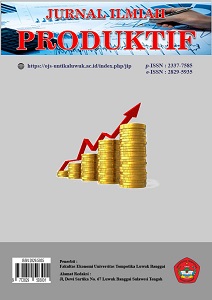Perencanaan Kebutuhan Bahan Baku Guna Meningkatkan Efisiensi Produksi Batik Nambo Pada Rumah Industri Mutiara
Planning of Raw Material Requirements to Increase the Efficiency of Nambo Batik Production at Mutiara Industrial House
https://doi.org/10.56072/jip.v13i2.1036
Keywords:
Raw Material Planning, Production Efficiency, BatikAbstract
The research was conducted at the Nambo Mutiara ikat and batik stamp industry, located in Nambo Bosa Village, Nambo District, Banggai Regency, Central Sulawesi. The purpose of the study was to determine the management of raw material inventory in order to increase the efficiency of Nambo batik production, using the Economic Order Quantity (EOQ) analysis method in determining the quantity of orders to be stored in the factory and the cost of orders to order the required inventory. The average raw material is IDR 50,000/cloth, dye IDR 1,200,000/package, wa/wax IDR 375,000/piece, with the cost components of ordering ship, bus, and courier costs amounting to IDR 520,000 per order, it is known that the number of raw material orders for a year is 1,116 pieces of cloth, 24 packages of dye, and 87 pieces of wax/wax. The calculation of the cost of ordering raw materials for a year is Rp6,240,000 for cloth, Rp6,240,000 for dye and Rp6,240,000 for wax = Rp28,134,961. The storage costs in the form of warehouse maintenance and electricity are Rp1,250,000, the calculation of the storage costs for raw materials is Rp58,125,000 for cloth, Rp1,250,000 for dye, and Rp4,531,250 for wax = Rp63,906,250. The results show that the total inventory costs that must be borne by the industrial house are Rp92,041,211. Controlling raw material inventory using the EOQ method, based on the calculation, the economic quantity for the order size for each type of raw material is 105 sheets of cloth, 15 dye packages, and 29 pieces of wax, with a lead time calculation for ordering is 12 days.
Downloads
References
Adhim, M. A., Zahra, A. M., Setiawan, A. N., Rukmana, F. V. C., & Pasaribu, L. R. A. (2024). Penerapan Metode Economic Order Quantity (EOQ) Untuk Meningkatkan Efisiensi Pengendalian Persediaan Bahan Baku di Kelana Roaster. Go-Integratif Jurnal Teknik Sistem Dan Industri, 5(2), 109–119. https://doi.org/10.31294/jp.v19i2.11342.
Ambarwati, R., & Supardi. (2021). Manajemen Operasional Dan Implementasi Dalam Industri. Pustaka Rumah Cinta.
Andries, A. L. (2019). Analisis Persediaan Bahan Baku Kedelai Pada Pabrik Tahu Nur Cahaya Di Batu Kota Dengan Metode Economic Order Quantity (EOQ). Jurnal Emba, 7(1), 1111–1120.
Damayanti, N., Listiawati, & Wiguna, W. (2022). Manajemen Operasional Era 5.0 (Ke-1). Cv. Aa. Rizky.
Dermawan, J., & Muhaimin, A. W. (2015). Perencanaan Dan Pengendalian Persediaan Bahan Baku Jamur Tiram Di Industri Rumah Tangga Ailani Kota Malang Jawa Timur. Habitat, XXVI(1), 22–30.
Mayusda, I., Akbari, A. D., Sasongko, A., Suhardini, D., Ismail, M. L., & Kaban, D. T. (2025). Pelatihan Digitalisasi Perencanaan dan Pengendalian Produksi Batik di Sanggar Batik Kembang Mayang. Abdimas Universal, 7(1), 117–122.
Palupi, P. M., Korawijayanti, L., & Handoyono, R. (2018). Penerapan Metode Economic Order Quantity (EOQ) Untuk Meningkatkan Efisiensi Biaya Persediaan Bahan Baku ( Studi Kasus pada PT Nusamulti Centralestari ). Prosiding Seminar Nasional Unimus, 1, 426–435.
Rajindra, Umar, & Nurpadia, J. (2022). Perencanaan Kebutuhan Bahan Baku Guna Meningkatkan Efisiensi Biaya Produksi Pada CV. Solo Indah Kota Palu. Jurnal Sinar Manajemen, 9(2), 335–341.
Rusdiana, K. R., & Haris, I. A. (2018). Analisis Perencanaan Dan Pengendalian Persedian Bahan Baku Baju Kaos Dengan Metode Economic Order Quantity (EOQ) Pada Jims Kaos Tahun 2017. Jurnal Pendidikan Ekonomi Undiksha, 10(1), 54–64. https://doi.org/10.23887/jjpe.v10i1.20054
Suratman, F. A., & Sutrisno. (2023). Analisis Perencanaan Persediaan Untuk Mengurangi Biaya Persediaan Bahan Baku Dengan Metode Economic Order Quantity di PT XYZ. Jurnal Terapan Teknik Industri, 4(1), 66–77. https://doi.org/10.37373/jenius.v4i1.459
Wibowo, H., Khikmawati, E., & Hariyanto, I. W. A. (2017). Analisis Perencanaan Kebutuhan Bahan Baku Kayu pada Produk Kursi Goyang Bali dengan Pendekatan Minimasi Biaya (Studi kasus : CV Meuble Puspa Jaya). Journal Industrial Services, 3(1), 74–79.
Widhianingsih, W., & Wahyuni, H. C. (2023). Peningkatan Produktivitas Sepatu Melalui Pengendalian Persediaan Bahan Baku Dengan Metode Economic Order Quantity (Eoq) (Studi Kasus: Cv Yunanda, Sidoarjo). Industri Inovatif, 32–38.
Downloads
Published
How to Cite
Issue
Section
License
Copyright (c) 2025 Yusnita Fitarini Sibay, Heny Ariwijaya

This work is licensed under a Creative Commons Attribution 4.0 International License.











